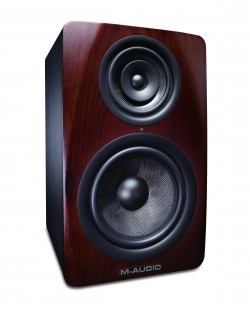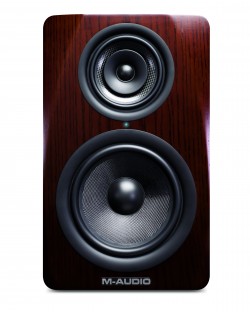 Today M-Audio announced the availability of their new 3-way M3-8 studio reference monitor.
Today M-Audio announced the availability of their new 3-way M3-8 studio reference monitor.
Featuring an innovative inline design and superior imaging, the compact M3-8 delivers an “immersive” audio experience with dedicated low-, mid-, and high-frequency drivers, each with its own dedicated amplifier.
M-Audio Product Manager, JC Sutherland, explains, “One of the biggest upsides to having a three-way design is accuracy in the lower mid-range frequencies — M3-8 has a dedicated driver for that often-muddy range, which can be too high for a woofer and too low for a tweeter to handle. M3-8’s three-way coaxial design successfully addresses that challenge.”
 M3-8’s high- and mid-frequency drivers are coaxial, with the mid surrounding the high, allowing for a compact standard-size monitor that offers rich audio detail and a wide “sweet spot” for accurate mixing. The inline design provides three-way sound in the same space as a standard two-way monitor.
M3-8’s high- and mid-frequency drivers are coaxial, with the mid surrounding the high, allowing for a compact standard-size monitor that offers rich audio detail and a wide “sweet spot” for accurate mixing. The inline design provides three-way sound in the same space as a standard two-way monitor.
M3-8’s 8-inch low-frequency and 5-inch mid-range driver are made of lightweight woven Kevlar, and the 1-inch silk dome tweeter features integrated waveguides to provide increased clarity. In addition to the real wood baffle, the cabinet provides tuned bass porting and optimized internal bracing to produce the highest levels of fidelity.
Pricing and Availability. M-Audio’s new M3-8 studio reference monitors are now available in stores, sold individually with a suggested “street” price of $349 per monitor. For additional information, check out the m-audio website.

I was checking out the website specs and it stated “40 Hz ~ 20 kHz” for a range. I’m curious, why is it my headphones can do like 15 Hz to 20 kHz but studio monitors like these bottom out around upper 30 Hz. Does it not matter that monitors like these don’t span 20 to 20?
My dog said he’s not buying these cause they don’t go to 40 kHz.
I said, “what? I can’t hear you”
True, I wonder too…
Because headphone driver are smaller, so????
Only reason I can think of is speakers avoid really low frequencies to avoid messing up the sound in the acoustic space and try to preserve the flatness across the spectrum, while for headphones the space is always pretty much the same.
But I’d like to have proper explanation.
ps: those speakers look sweet
Dear friend, this call physics, the amount of air between headphone drives and your eardrum, they are very small quantity of air, the prove is when you take the headphone away from your ear, the sound come thin, the movement of the speaker(mechanical) need to brake a lot of air particle before reach your eardrum, the big is the distance, big and powerful need to be the speakers to reproduce particularly bass. Very simple test, claps 2 fingers(they brake small quantity of air particle) now clap your palms and you hear the difference. This call Physics.
Small (5″-6″) monitors can’t go lower than that as the driver is too small to vibrate at lower frequencies with sufficient power to produce sound (you’ll hear it flapping about a bit though). In this case with 8″ drivers I think maybe because the box is too small for the bass port to allow such low frequencies through (low freq/longer wavelength requires greater port size, go read some acoustics/sound wave theory stuff for a better explanation). Can’t explain why headphones can, but probably to do with the fact that they don’t have to produce anywhere near as much amplitude. Anyway, you’d want to have the environment to support those sub frequencies if you wanted to mix them decently. 20-20 doesn’t matter if you’re in a bedroom the size of a portaloo, it’ll still sound shite (on a side note these monitors will probably sound shite regardless of what you do to them).
@yup yup : The most important is what human can perceive, mainly with you hear, and sometime your body (for high volume bass frequencies), ususally not lower than 50Hz and not higher 18 Khz.
Headphones are so close to your ear that they only have to deal with a little amount of air. They need little energy to make that air move and reach your eardrums. This is why they only need tiny speakers.
Speakers on the other hand have to “energize” a large quantity of air, so they have to be big and consume more energy. Low frequency needs more energy and a larger speaker area.
But 20Hz from a big subwoofer is not the same as 20Hz on headphones. Subwoofers produce bass you can feel all over your body 😉